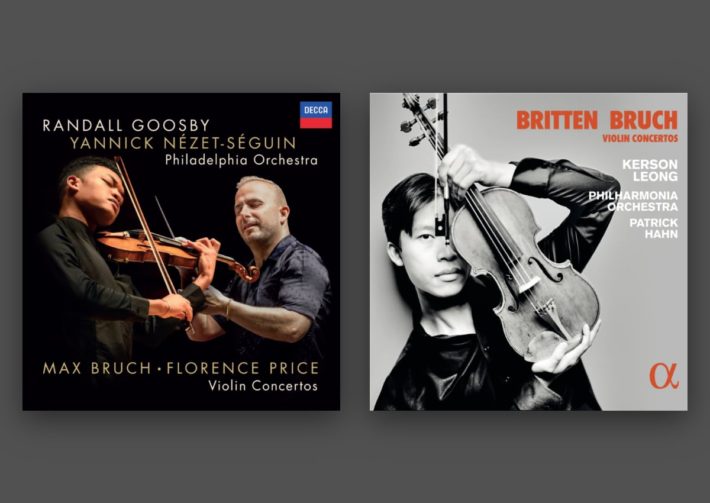These two recordings both feature Max Bruch’s Violin Concerto but otherwise offer distinct selections. Kerson Leong, with the Philharmonia Orchestra, complements his Bruch performance with Britten’s concerto and Op. 65 In Memoriam. Goosby, on the other hand, features Florence Price’s two Violin Concertos as part of the Philadelphia Orchestra’s large-scale project to record all of her orchestral works. Last year, we reviewed the ensemble’s recording of her symphonies.

Amazon: Britten & Bruch Violin Concertos – Kerson Leong (violin), Philharmonia Orchestra

The opening cadenza of the Bruch reveals much about the performer’s approach and temperament. With divergent but well-executed versions, it might well be a toss up for preference. Goosby’s is quite polished: different characters across the lower and higher registers create dimensionality. His supple playing generates a suspense that drives the movement’s drama forward fluidly. Leong’s is more introspective: dwelling on certain notes mindfully, he evokes a raw pathos that allows the instrument to take on a convincingly human quality.
The Adagio requires treading a fine line between sensitivity and sensibility. Fortunately, both performers find the right balance and give excellent performances that communicate the beauty of Bruch’s lines. As in the prior movement, Leong makes it seem like he’s playing to the listener alone. His interpretation feels a little more forward in how his phrasing beckons, at times coyly and at others more persuasively. A large part of this personal quality has to do with his stellar rubato, which is both resonant and warm. Goosby’s take feels a hair lighter where vibrato and bowing are concerned but introduces a different sentiment—a delicate wistfulness that is no less arresting. The textures of the movement clearly reveals the differences in sound engineering, which in this case works in Leong’s favor. The balance in his recording puts him front and center, while the Decca engineers have Goosby on more level footing with the ensemble. While the latter results in a beautiful integration of parts, the soloist deserves far more attention.
The jubilant finale calls for technical mastery of spiccatos and double stops. Both performers rise to the occasions: Goosby plays his phrases with the litheness of a gymnast, while Leong adds a bit of stubborn emphasis to the intervals. The respective ensembles do their part not just to support the soloist but also help maintain the energetic drive throughout.
Related Classical Music Posts
- Review: “Roots” – Randall Goosby, Violin
- Review: Beethoven – Violin Concerto – María Dueñas, Wiener Symphoniker, Honeck
- Review: Beethoven – Complete Symphonies – Nézet-Séguin, Chamber Orchestra of Europe
The companion works on each album are most welcome additions. For Leong, the Britten concerto offers a striking contrast to the Bruch: stark dissonances and stringent textures create a perfect storm of eeriness, disquietude, anguish, and aggression—all which the musicians capture with aplomb. Leong handles some of the most charged moments with an almost brazen (but always musical) fierceness that really embodies the spirit of the work.
Goosby’s live performance of the Florence Price concertos was taken from four concerts he played in October 2022. The first few moments of the Tempo Moderato (track 4) alone reflect noticeable parallels in structure and compositional elements to Tchaikovsky’s Violin Concerto. Similarity aside, Goosby’s interpretation places focus on a sense of melodic freedom in the runs and flourishes–and also Price’s occasional penchant for polished virtuosity. What’s especially nice is how he plays with a sense of pure joy. The thematic material at 1’28”, for instance, is delightfully pastoral, especially in the lovely interchanges with the bassoon; 3’30” onwards greets our ears with a more playful buoyancy. Goosby’s tone, regardless of technical demands, is faultlessly silky and fits right into the character of the movement.
In the Andante, the orchestra’s clarity and transparency reveals Price’s adventurous harmonic suspensions and unexpected color shifts. Goosby has plenty of tenderness in his melodies; the only fault might be that his lower register playing (which features often), doesn’t ‘speak’ enough and could use a thicker and richer timbre.
Concerto No. 2 showcases a much more unique style which pairs interesting, if not contrastive elements: for instance, the robust martial character of the introduction is interrupted by mysterious percussive chimes that give way to an expansive and idyllic section of colorful, Impressionistic harmonies. Once again, Goosby’s lithe phrases and finessed bow control makes the violin’s lines sound elegant and whimsical.
With undoubtedly solid performances of the Bruch and companion works on each album Goosby, Leong, and their respective orchestras deliver thoroughly enjoyable listening experiences. A choice is hard to make here; both recordings deserve places on any listener’s shelf.

Bruch – Violin Concerto No. 1, Florence Price – Violin Concertos
Randall Goosby – Violin
Philadelphia Orchestra
Yannick Nézet-Séguin – Conductor
Decca, CD 4854234

Britten & Bruch- Violin Concertos
Kerson Leong – Violin
Philharmonia Orchestra
Patrick Hahn – Conductor
Alpha, CD ALPHA946

Recommended Comparisons
Mutter & Karajan | Perlman & Haitink | Lin & Slatkin | Bell & Marriner
Read more classical music reviews or visit The Classic Review Amazon store
Follow Us and Comment:
Get our periodic classical music newsletter with our recent reviews, news and beginners guides.
We respect your privacy.









